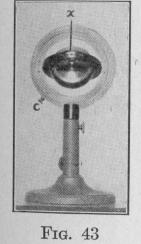52 MOTION OF A SPINNING BODY
airplane without causing the machine to tilt, it is necessary to use not only the vertical rudder to produce the turn but also the horizontal rudder to neutralize the tilt that otherwise would be produced by precession. If the airplane has two similar propellers rotating in opposite directions with equal speed, then the preces
sion will be zero.
Questions. 1. Show that in the case of an airplane with a propeller rotating counter-clockwise as viewed by a person looking from aft forward, a turn to the right tends to make the plane soar.
2. Show that an airplane, with a propeller rotating in the clockwise direction as viewed from aft forward, can be turned to the right by elevating a horizontal rudder at the stern.
3. Show that if an airplane makes a sharp turn about a vertical axis and banks properly to furnish the required centripetal force, the airplane will precess about a horizontal athwartship axis causing the nose to dip, even though the engine is not running. Aviators sometimes ascribe this phenomenon to a " hole in the air."
4. In what direction would a horizontal rudder at the stern of an airplane need to be tilted so as to prevent the airplane turning about an athwartship axis while making a turn to the right, the rotation of the propeller being clockwise?
5. In what direction would a horizontal rudder at the stern need to be tilted in order to make a turn to the right without using the vertical rudder, the rotation of the propeller being clockwise?
6. Would the trailing edge of a vertical rudder need to be moved to port or to starboard in order to make the bow of the airplane rise, the rotation of the propeller being clockwise?
7. The Pitcairn-Cierva Autogiro is an airplane to which is added a set of long vanes carried by a hub fastened rigidly to the airplane so that the vanes can revolve above the cockpit about a vertical axis. Each vane is pivoted to the hub in such a way that it can set itself at an angle of 90° or less to the axis of rotation. In starting the airplane, both the propeller and the hub are rotated by the engine in the clockwise direction as viewed by the pilot who is behind the propeller and below the hub. As soon as the airplane is free of the ground, the hub is disconnected from the engine. The motion of the airplane through the air thereafter causes the vanes to rotate about the vertical axis of the hub and also to rise like the ribs of an umbrella turned inside out.
Deduce the direction of any precession of the airplane while (a) the propeller is being accelerated; (b) the right wing is being lifted by a gust of
wind.
34. Magnitude of the Torque Required to Maintain a Given Precessional Velocity when there is Zero Motion about the TorqueAxis, and when the Axes of Spin, of Torque and of Precession are
Perpendicular to One Another. Experiment. - Stand on a rotatable stool while holding in the hands a bicycle wheel provided with
MOTION OF A SPINNING BODY 53
a massive tire of lead or iron wire. While the wheel is spinning with
the axle horizontal, incline the right-hand end of the axle down
ward, then upward. Observe the considerable torque required to
tilt the axle. Also observe that the rotatable stool turns about a
vertical axis in one direction when the right-hand end of the axle
is being tilted downward and turns in the opposite
direction when the same end of the axle is being
tilted upward.
Experiment. -When a gyro-wheel of the gyro
scope in Fig. 42 is not spinning, push downward against the point x with the rubber-tipped end of a lead pencil. Observe the effect and the amount of push exerted.
Fasten together the two outer rings of the gyro
scope by means of a clamp C, Fig. 43. Set the gyro-wheel spinning. Push downward against the
point x as before and observe the effect and the amount of push exerted.
Detach the clamp so that the gyro-axle can precess. Set the gyro-wheel spinning. Push downward against the point x as
before and again observe the effect and the amount of push exerted.
Attach the small mass furnished to the frame at x, Fig. 43. With the clamp C removed, set the wheel spinning in the direction indicated. Observe now that the torque due to the weight of the added
mass produces a precessional motion about a ver
tical axis but that it produces inappreciable motion
of the spin-axle about the axis of the torque.
Observe that after the precession has become
uniform, the angular momentum produced by a constant torque about an axis perpendicular to the spin-axle does not increase the total angular momentum of the wheel but it changes the direction of the axis of angular momentum. This is analogous to the fact that centripetal force does not increase the total linear momentum of a body traveling in a circular arc but it changes the direction of the linear momentum.
We shall now deduce the relation between the precessional velocity, the angular momentum about the spin-axis, and the torque acting on a body that is symmetrical with respect to both the spin-axis and the precession-axis. Represent the magnitude

